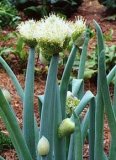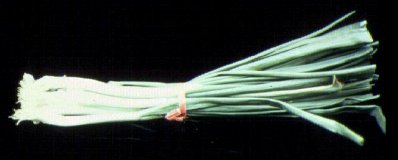Chinese Onion
http://www.100md.com
《e Natural Health Center》
 |
 |
 |
Herbs for Dispelling Wind and Cold
Chinese Onion
Latin:
Radix Allium fistulosum L
Origin:
As the bulb near the root of Allium fistulosum L., a perennial food-herb, of the family Liliaceae. Native to Siberia and neighboring Kazakhstan, it is very popular in the East. It was brought to Europe in the 17th century, and is now grown in various parts of the world.
, 百拇医药
The leaves of Chinese onion are round, hollow, and inflated the entire length of 12-40 cm. The flower stalk (scape) is also hollow. The plant has only slightly enlarged bulbs, which are very long and are covered with dry membranous, onion-like scales for some distance aboveground. The color of the bulbs ranges from white to pink. The black, angular seeds are similar to common onion seeds.
The bulb grows to about 0.6 m by 0.2 m. It is not frost tender. It is in flower in July. The flowers are hermaphrodite (have both male and female organs) and are pollinated by bees and insects. The plant cannot grow in the shade. It requires moist soil.
, 百拇医药
In China, Chinese onion is planted all over. It can be planted in the fall, winter, or spring, using seeds or divisions (transplants). Plants multiply by producing side shoots which can be divided and reset. The perennial type produces no seed, so must be propagated vegetatively.
Harvested at any time and used when raw, the entire plant may be pulled and eaten like a green onion as early as when 6-8 cm high, or leaf portions may be snipped off as needed for flavoring. If pulled as a green onion, 4-5 months are required from seeding to harvesting. In general, the white portion (the bulb) is used for medicinal purposes.
, http://www.100md.com
Also called Japanese Leek, Bunching Onion, Spring Onion, Welsh Onion (derived from the German word "welsche", meaning foreign.)
See also Food, Vegetables, Chinese Onion and Onion.
Properties:
Pungent in flavor, warm in nature, it is related to the lung and stomach channels.
Functions:
Removes superficies syndrome, clears away toxic materials, dispels wind, eliminates dampness, clears passages and alleviates pain.
, 百拇医药
It is used to treat chills, fever and headache due to exogenous febrile diseases, abdominal pain due to yin-cold, ascaris instestinal obstruction, constipation, dysentery, carbuncle and swelling.
Applications:
1. Used for common colds due to pathogenic wind-cold:
This herb disperses pathogens with its pungent taste and clears obstructions with its warm nature and it possesses mobile and penetrating properties with its effects reaching the superficies and the interior, so it can induce sweat, relieves exterior syndromes and dispel cold, but as it has a rather weak potency, it is suitable for those who have lighter cases of common colds due to pathogenic wind-cold together with ginger and fermented black soybeans in order to strengthen the functions of inducing sweat and relieving exterior syndromes, e.g., Lianxu Chongbai Tang or Chong Chi Tang.
, 百拇医药
2. Used for yang kept externally by yin-excess in the interior, diarrhea with faint pulse and abdominal pain with coldness of the genitals:
This herb disperses pathogens with its pungent taste and clears obstruction with its warm nature, so it can activate the circulation of yang-qi and remove qi stasis due to cold. It is often used together with aconite root (Radix Aconiti Carmichaeli) and dried ginger in order to activate yang and return the adversely-flowing qi, e.g., Bai Tong Tang. Alternately, mash Chinese Green Onion, apply it onto the navel and then warm the back in order to treat abdominal pain with coldness of the genitals, qi stasis due to cold and dysuria (painful or difficult urination) due to disturbance in qi transformation, thus activating yang and dispelling cold.
, http://www.100md.com
In addition, the external application of Chinese onion can dissolve lumps, remove obstructions in the channels and stimulate milk secretion, so it can treat such ailments as stagnation of milk, mastalgia (breast pain), etc. It can also remove poisonous substances and dissolve lumps in the treatment of skin and external diseases and furunculosis (persistent sequential occurrence of boils, skin infections).
Dosage and Administration:
, http://www.100md.com
3-10 g.
The bulb can be consumed raw or cooked. A strong onion flavor, it can be used in salads, as a cooked vegetable or as a flavouring in cooked foods. The bulbs are rather small, perhaps 25 mm in diameter, and are sometimes used as spring onions.
When cooked, decoct the bulb for drinking, or boil it in alcoholic drinks for oral administration.
Leaves can also be consumed raw or cooked. They have a mild onion flavor and can be added to salads or cooked as a vegetable.
, 百拇医药
When used externally, it is to be pounded and applied to the affected area, or parched for hot medicated compress, or decocted to bathe the affected part, or wrapped in a cloth and inserted into the ear or nose.
Cautions on Use:
It should be avoided by patients who shows spontaneous perspiration caused by exterior deficiency.
Although no individual reports regarding this species have been seen, there have been cases of poisoning caused by the consumption, in large quantities and by some mammals, of certain members of this genus. Dogs seem to be particularly susceptible.
, http://www.100md.com
Reference Materials:
'Shen Nong's Herbal Classic' :
"It is indicated for febrile diseases, chills and fever, excessive sweating, apoplexy (haemorrhage into the brain or stroke) and facial edema (abnormally large amounts of fluid in the intercellular tissue spaces of the body)."
'Compilation of Materia Medica' :
"Used as Zhong Jing Bai Tong Tang or Tong Mai Si Ni Tang to induce sweat, expel pathogenic factors from muscles and skin and promote the circulation of upper and lower yang-qi as well as to remove obstructions in the channels to return the adversely rising yang. In particular, it should be used by anyone who has a flushed face with yang kept at the upper part."
, 百拇医药
Toxic or Side Effects:
Although no individual reports regarding this species have been seen, there have been cases of poisoning caused by the consumption, in large quantities and by some mammals, of certain members of this genus. Dogs seem to be particularly susceptible.
Modern Researches:
Chinese onion bulb contains a volatile oil whose main ingredients include allicin, allyl sulfide, malic acid; it also contains protein, fat, carbohydrate, fibre, ash, phosphorus, sodium, potassium, thiamine, riboflavin, niacin, ferric salt, calcium, iron, magnesium, vitamins A, B1, B2 and C, etc.
, 百拇医药
The volatile ingredients in onion bulb is bacteriostatic to many microbes, including bacilli of diphtheria (acute infectious disease of the upper respiratory tract), tuberculosis, dysentery (inflammation of the intestines), staphylococcus and streptococcus. Its water infusion (1:1) also reveals inhibition on pathogenic fungus of the skin in vitro.
In addition, it is used in the treatment of colds and abdominal coldness and fullness as it has effects of reducing fever by sweating, inducing diuresis (increased excretion of urine), invigorating the stomach and dispersing phlegm.
A tea made from the roots is a children's sedative. Use of the bulb in the diet impedes internal parasites. Externally, the bulb can be made into a poultice to drain pus from sores, boils and abcesses.
The leaves contain about 1.4% protein, 0.3% fat, 4.6% carbohydrate, 0.8% ash, some vitamin B1 and moderate levels of vitamin C., http://www.100md.com